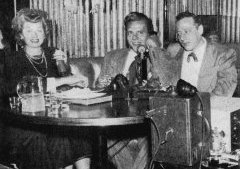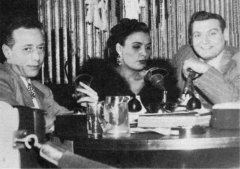
Lucille Ball, Desi Arnaz, Jack Eigen |

Jack Eigen with the Copa Girls |

Jack Eigen, Lena Horne, Frankie Laine |
| The storied Copacabana, which Barry Manilow turned into a household name with his 1978 hit song, and later, a theatrical production and film, has been featured in several highly acclaimed movies. In Copacabana (1947) a theatrical agent (Groucho Marx, in his first solo role without his siblings, the Marx Brothers) has his only client (Carmen Miranda) pose as both a French chanteuse and a Brazilian bombshell to fool the ersatz Copacabana nightclub owner into hiring her as both acts; also featured in the film are real-life Copa performers Raul and Eva Reyes, Dee Turnell, and Copa Girls Jill Meredith and Toni Kelly. |
| GoodFellas (1990) is a crime drama based on the true story of mob informer Henry Hill (Ray Liotta), whose early life of violence as a member of the Lucchese family is offset by quieter times, such as his regular visits to the famous Copacabana nightclub. |
| As in GoodFellas, actual film footage of the Copacabana can be seen in: I Surrender Dear (1948), which includes a four-minute sequence with Copa lounge celebrity radio host Jack Eigen; Raging Bull (1980); and Tootsie (1982). The French Connection (1971), a true story sparked by a romance between a Copa hat check girl and NYPD detective Eddie "Popeye" Doyle, starts and ends at the Copacabana, but was not filmed on location. The Joker Is Wild, which tells the story of Joe E. Lewis, includes footage of the famous nightclub comedian performing at the Copacabana, but the scenes were shot on a set at the Paramount lot; similarly, Beyond the Sea, which chronicles Bobby Darin's ascent from shady nightclubs to his dream destination, the Copacabana, utilizes a movie set for the Copa scenes. |

Lucille Ball, Desi Arnaz, Jack Eigen |

Jack Eigen with the Copa Girls |

Jack Eigen, Lena Horne, Frankie Laine |
|
In
spring 1947, radio disc jockey Jack Eigen introduced "Meet Me at the Copa,"
a program featuring records, talk, and interviews with guest celebrities,
broadcast live from one of New York's busiest nightclubs - the Copacabana
lounge. Weeks prior Eigen had pitched the innovative concept of broadcasting
from a nightclub - not a radio station, as typical of the times - to Jules
Podell. The Copa boss immediately recognized its potential to bring
in a lot of people to see the celebrities and hear them on the air, and
increase business. Podell contacted station WINS to install two microphones,
which were connected by telephone wire with WINS studios. Three telephones
were put in, two for listeners to call the show, and the third with a private
number for friends and others who could call Eigen with special information.
Air time was set for four hours every morning, midnight until four, seven
days a week.
On the night of April 22, 1947 the engineer signaled to Eigen, and his first broadcast was underway. It opened with Eigen's own special theme song, Jack, Jack, Jack, sung by the five DeMarco Sisters. Then Eigen came on:
"Good morning, ladies and gentlemen,
this is your Broadway and Hollywood reporter, Jack Eigen, coming to you
from the very beautiful and very glamorous lounge bar of the Copacabana
at Ten East Sixtieth Street in New York City.
The lights on the phones began flashing as the calls started coming. People were up out there and they were listening, and they would continue to listen and call, from as far north as Canada, as far east as Bermuda, as far south as Miami, and as far west as Illinois, for the three-plus years that the show was on the air. People heard the show, with the guest celebrity interviews, the kidding, the banter, and they wanted to come in to witness for themselves the fun, the glamour, the excitement, and the celebrities in the magical atmosphere of the Copacabana nightclub. Click here to hear a clip taken from the June 6, 1948 Fred Allen Show radio broadcast with special guest Jack Eigen in a simulation of a "Meet Me at the Copa" session. Click here to download a 90-second clip from the 1948 Columbia Pictures movie I Surrender Dear. The scene, featuring Jack Eigen in a simulated interview with bandleader Frankie Carle, was filmed on location in the Copa lounge.
By summer 1956, Dean Martin and Jerry Lewis officially announced that they were breaking up as a team; however, together they were committed to one last engagement at the Copacabana. Perhaps because it was the last time they would ever work together, Martin and Lewis' final two-week stand at the Copa did a record-breaking business. The diminished floorshow space was a tribute to their draw and mass impact. The Doug Coudy production numbers were curtailed as the acts, including the personable dance team of Conn & Mann, were stage waits for the headliners. Martin & Lewis worked with smoothness and no apparent personal friction despite all the press about their rift, but some dissension was evident with their Pardners bit, a cafe trailer for their soon-to-be released Paramount film of the same name. To their professional credit they played it straight, with Lewis foiling for Martin's crooning, and likewise, Martin foiling for his partner's clowning. While both were well received, it was felt that solo or team, the impact was not as resounding as in the past until their final night. Every celebrity in Manhattan was in the audience to witness the pair's swan song of one of the greatest comedy acts in history. They pulled out every schtick in their comedy bag for the star-studded crowd, from squirting seltzer down Milton Berle's shirt front to cutting off Monte Proser's necktie. The sophisticated cafe crowd wouldn't let them quit. The final moments of the last show of their farewell engagement at the Copa on a hot Tuesday night, July 24, 1956, are pressed indelibly in the minds of those who were present. Martin's face was impassable, cool to the end. They finished with the final crescendo from Pardners: "You and me, we'll be the greatest pardners, buddies, and pals!" They joined hands for a last bow. Martin hugged Lewis. The audience exploded in an emotional uproar. Jackie Gleason jumped up and grabbed the mike, wiped away a tear, and said, "Folks, this can't be allowed to happen." The audience roared its approval, but Martin & Lewis just shook their heads, no. It was over. There was no encore. Martin took one aisle away from the floor; Lewis took the other.
Visitors to this page who have Real Player installed on their computer
can enjoy the following clips of Dean Martin and Jerry Lewis performing
onstage at the Copacabana in the early fifties by clicking on the links
below.
M&L Clip 2 (Jerry Lewis introduces Dean
Martin)
|